- Get link
- X
- Other Apps
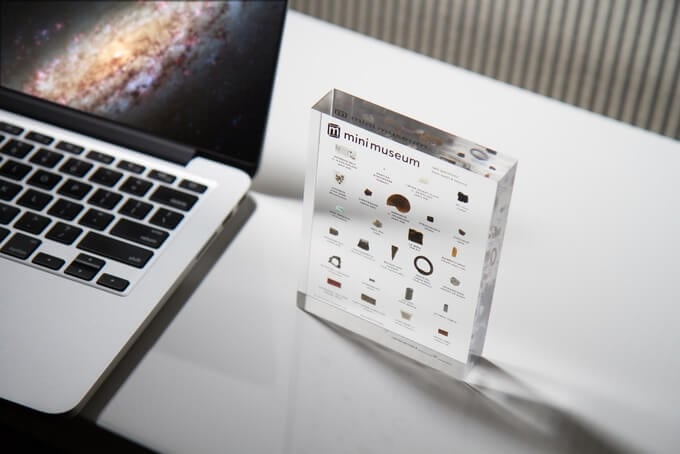
I could not ignore this request, . Hans Fex, creator of the "Mini Museum" (Mini Museum), a portable collection of curiosity from all over the Earth and its outlands, collects money for the realization of his idea. "Billions of years of life, science and history in the palm of your hand," the creator declares. - Selected by hand for future generations. " A week remains, but the collection has already collected more than a million dollars (and needed only 160,000). Let's see what kind of miracle it is.
The mini-museum is a hand-crafted and numbered collection of limited edition designed for inspiration. Each sample of the mini-museum is authentic, iconic and marked. Hans collected rare and remarkable objects for most of his life, since his father gave him the first samples in 1977. These were samples from Malta.

"For many years I was lucky to meet many amazing people, including scientists, curators of museums and other adventurers. With their help, I managed to collect an incredible collection, which I now share with the world. "
Obviously, it was rather difficult to create such a mini-museum.
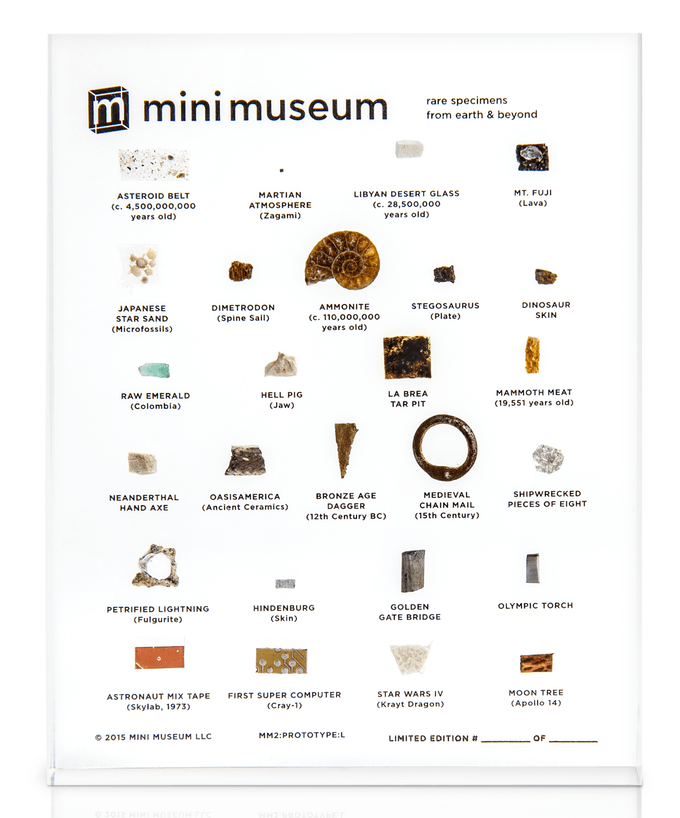
Each sample needed a unique approach, and Hans had to consult artisans around the world. He says many times he was told that he is trying to do something impossible. But his team found a way.
Of course, with any manual work like a "mini-museum", there will always be variations. There may be tiny air bubbles, or samples will vary in shape and size. Samples also shift slightly during the curing of acrylic. Such changes underscore the fact that each mini-museum is absolutely unique.
Within the framework of this project, Fex detailed the manufacturing processes of various samples. Some supporters of the project noted that the updates would be as important as the award itself. Therefore, he will do everything possible to go even further with the second version.
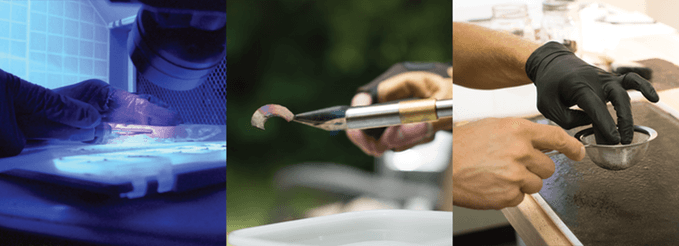
"Perhaps it will seem familiar to you, but I will say again: The universe is amazing. I really want to remind people about this. How wonderful it would be to have a collection of rare rocks from space, fossils of a dinosaur and ancient mammals, memory of dead civilizations and relics from the most discussed places and events in the history of mankind! And all this on the palm of your hand. "
Mini-museum is a portable learning tool and a wonderful example of historical art. Each mini-museum is done by hand and carefully placed in acrylic. You can put it on a table or even carry it in your pocket. Well, or give, of course.

The second edition of the Mini Museum contains 26 unique, carefully selected samples, beautifully laid out and clothed in acrylic Lucite. As you know, this collection was offered only once. And we can only walk through her incredible selection.
Asteroid belt (age 4 5,000,000,000 years)
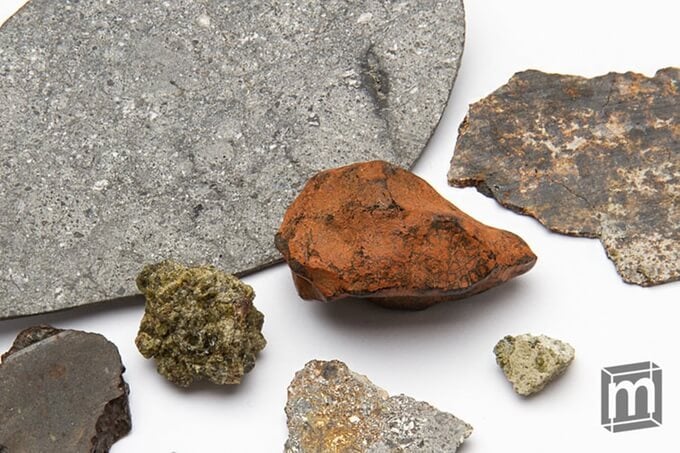
"They are so much like small stars that they are difficult to distinguish. Based on this, their star-like [asteroidal] species, if I had given them a name, I would have called asteroids. ” - William Herschel after observing Ceres and Pallas in 1802
Between the orbits of Mars and Jupiter is a ring of solid objects known as the asteroid belt. Most objects in the belt are less than 1 km in diameter, but there are several large, primordial remnants of the young Solar System, including the protoplanets of Ceres and the asteroid Vesta. The sample in the mini-museum contains a mixture of different classes of meteorites, known as HED meteorites (govardites-eukrites-diogenites). Direct observations of the Dawn spacecraft showed that HED meteorites came from a large impact basin in the southern hemisphere of Vesta.
The Martian atmosphere (Zagami)
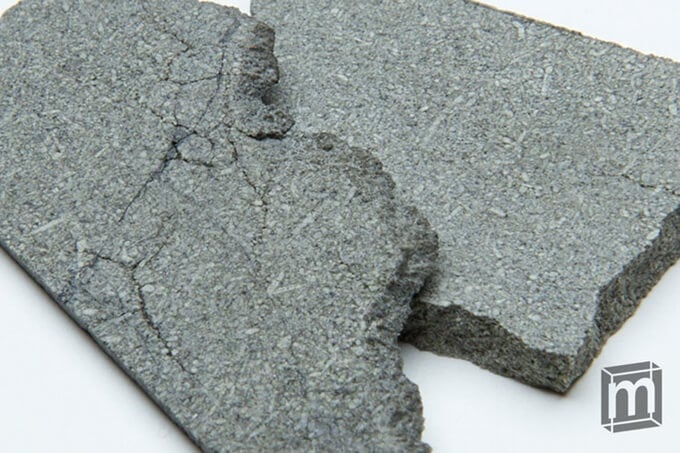
"Science is nothing more than a study of a miracle that we can never explain, and the art of interpreting this miracle." - Ray Bradbury, "Martian Chronicles"
Mars has a subtle atmosphere that contains a mixture of elements not found anywhere else in the solar system. A small number of meteorites contains traces of this atmosphere in the form of tiny pockets of impact-melting glass. Molecules trapped in a trap inside these meteorites keep the secrets of the distant past of our close neighbor in the solar system.
The sample in the mini museum comes from the meteorite Zagami, obtained directly from the hunter for the meteorites of Robert Haag, who also provides NASA samples in their studies. Zagami is one of the most studied Martian meteorites. In 2013, the rover "Kyuryoshiti" confirmed the early atmospheric studies of shock-melted pockets by direct observations on the surface of the planet.
Glass of the Libyan Desert (age 28 500 000 years)
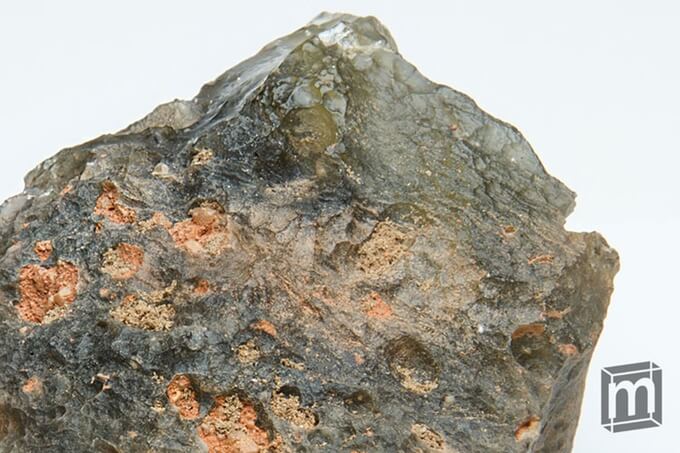
"The disintegration of zircon into baddeleyite and silicon glass at temperatures in excess of 1676 degrees Celsius demonstrates that the glass of the Libyan desert has a shock origin." - Barbara Kleinmann, Meteoritics & Planetary Science, 2001
The source of the opaque and light yellow-green glass of the Libyan desert remains a mystery. There are many theories about the source of this glass, but most points point to a massive blow. People have known about this glass since the Pleistocene era, creating tools and working with glass, including the creation of a scarab belonging to the burial of King Tutankhamun.
The sample in the mini-museum is taken from several large fragments of Libyan glass, including dark glass, which is believed to store extraterrestrial material from the source of the collision.
Mount Fuji (lava)
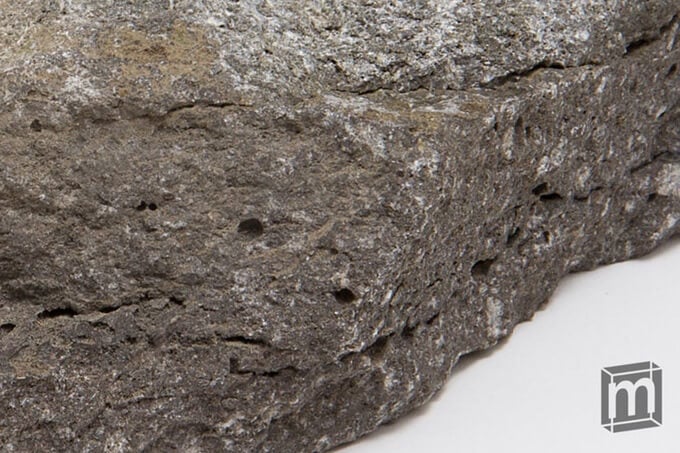
At its 3,776 meters, Mount Fuji is the highest in Japan. The modern Mount Fuji is represented by three volcanoes: Komitake, Ko-Fuji and Shin-Fuji. Over the past several hundred thousand years, each volcano grew from the remains of the previous one, together with Shin-Fuji, which was active about 10,000 years ago.
In 864 AD, the lava from the massive eruption of the Fuji volcano filled part of the ancient Lake Senumi, creating Lake Say, Lake Shoji and Lake Motosu. The remaining fertile land became known as Aokihagara Yukai, or "Sea of Trees". This tranquil region also has the notorious name of "suicide forest".
A sample of the mini-museum is taken from the sculptor near Aokihagara. For five generations, this sculptor's family produced sculptures for shrines around Mount Fuji.
Japanese starry sand (microfossils)
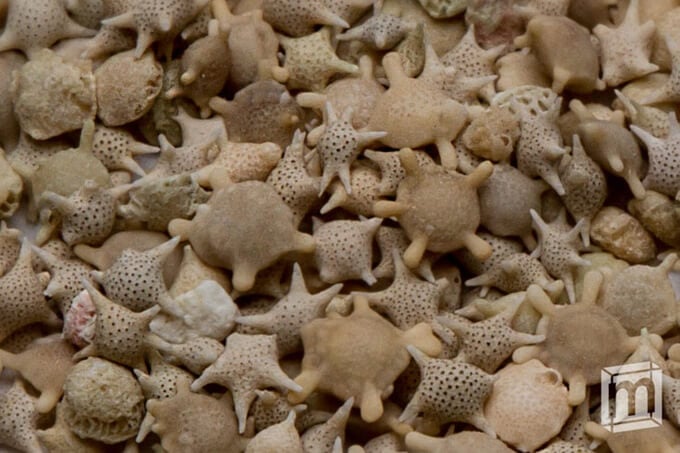
"Everything in nature, which seems insignificant at first sight, not only remains unknown to the masses, but for centuries has eluded the observations of those few who try to reveal the beauty of creation." - Alcie d'Orbigny, 1839
Foraminifera are single-celled creatures that produce a wide range of beautiful and tiny protective shells. These shells appeared in the fossil record 550 million years ago, and in some places whole beaches are made of these “fore-sands”.
The sample in the mini-museum is taken from a private collection collected many years ago on Hoshizuna-no-Hama ("star-sand beach") on the island of Iriomote in Okinawa Prefecture, Japan.
Dimetrodon (vertebra of the sail)

"The vertebra of this species was, apparently, flexible. The usefulness of this is difficult to imagine. " - Edward Drinker Cope, 1886
With its formidable jaw and reptilian appearance, dimetrodon is often mistaken for a dinosaur, although this species died out long before the era of the dinosaurs. Dating back to the early Permian period 300 million years ago, dimetrodon falls into a detachment of synapsides, which includes mammals. The appointment of the sarcastic vertebrae of dimetrodone is unknown, but studies indicate thermoregulation, sexual dimorphism, and possibly also movement.
The sample in the mini-museum is taken from several details of the sailing vertebra found in West Texas. This region, known as the Texas Red Beds, contains some of the most complete fossil records of the Early Permian period.
Ammonite (age 110,000,000 years)
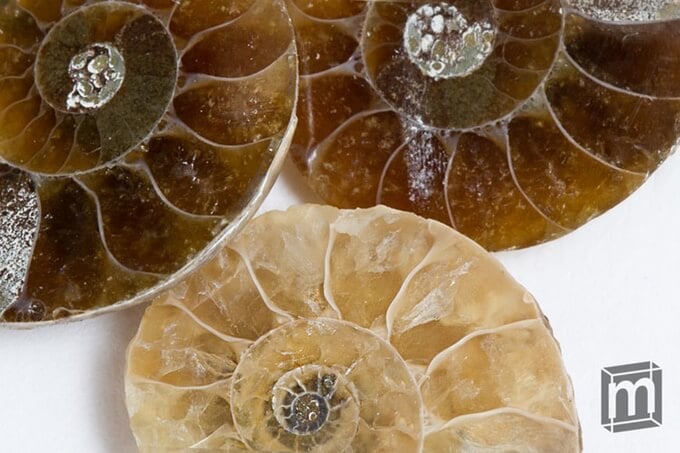
"Three times during their rule for more than 300 million years, the ammonites have experimented with the most bizarre and striking forms of the shell." - Wolfgang Grullke, author of the book “Heteromorph: the rarest of fossil ammonites”
Ammonites are an extinct group of marine cephalopods that entered the fossil record 400 million years ago. Their sign shells represent an almost ideal logarithmic spiral. This form is found in many natural phenomena, from the shape of galaxies and hurricanes to patterns on the heads of sunflowers and the flight of many animals.
The sample in the mini-museum is represented by Cleoniceras from Madagascar, isolated from the Albian stage of the Lower Cretaceous formations.
Stegosaurus (dorsal plate)
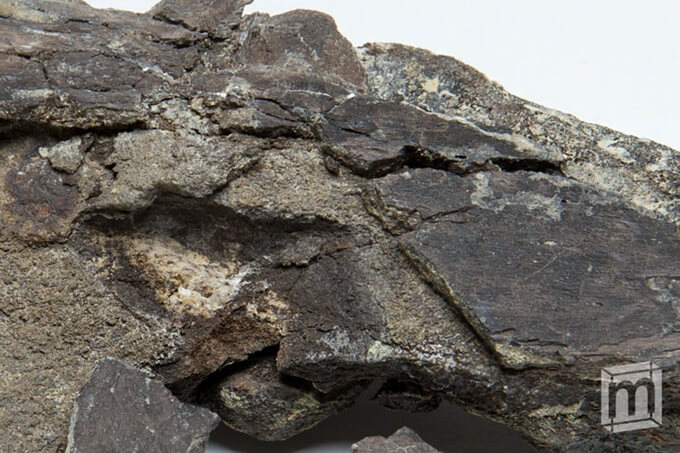
"The stegosaurs had to be magnificent under the attack - a five-ton ballerina with an armored head, waving bone triangles and shaking with a war hammer." - Robert T. Bakker
Stegosaurus is one of the most famous among all dinosaurs. Armored with two rows of bone plates and a tail with sharp spines, he conjures up pictures of how he protects himself from the teeth and claws of allosaurs, also residents of the Jurassic period.
The sample in the mini-museum came from a fragmented plate of the stegosaurus, restored and reconstructed by a paleontologist working on private land.
Skin of a dinosaur
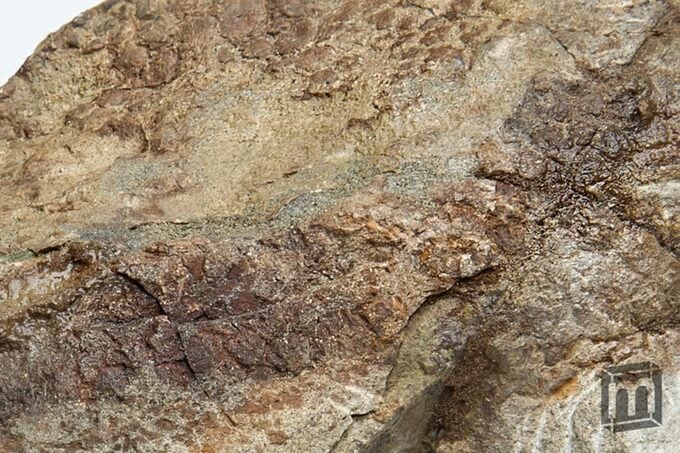
"Much of what is known about the morphology and taphonomy of dinosaur skin comes from several extremely preserved fossil hydrosaurs." - Matt Davis, Department of Geology and Geophysics, Yale University
When we think of dinosaur fossils, we usually represent bones and teeth, but along with them, feathers and petrified skin and scales were also found.
The sample in the mini museum was taken from Edmontosaurus, a species of Hadrosaur, which was distributed at the end of the Cretaceous era and was purchased directly from paleontologists working in this field on private land.
Coarse emerald (Colombia)
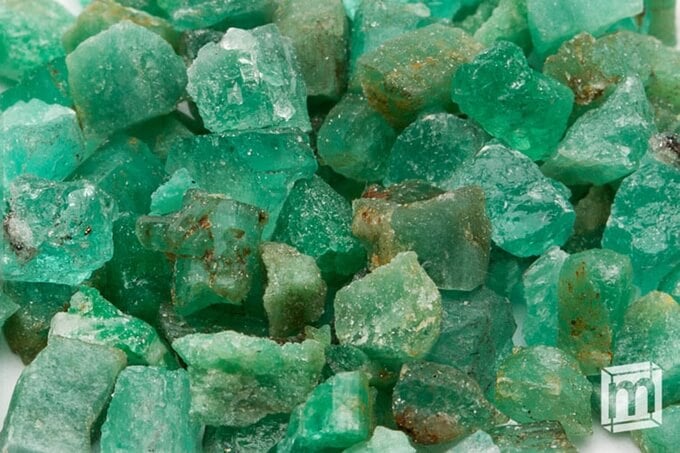
"A casual look at crystals can lead to the thought that they were pure manifestations of nature, but it's just an elegant way to point out someone's ignorance." - René-Juste Guyu, father of modern crystallography, who first classified the emerald as beryl
We often mark purity as the main sign of rarity and beauty, but in the world of crystals, it is impurity that often separates stones and makes them attractive. Aluminum silicate beryllium, also known as beryl, is a colorless crystal. However, the addition of chromium leads to the greening of beryl, and it becomes an emerald. Emeralds are less likely diamonds because of the complex geological forces that are necessary to produce the right combination of minerals.
The sample in the mini-museum is a coarse emerald from Colombia, purchased from a private seller. Colombian emeralds are unique in the world of emeralds because of the almost complete absence of iron, which often leads to a deeper green color.
Infernal pig (jaw)
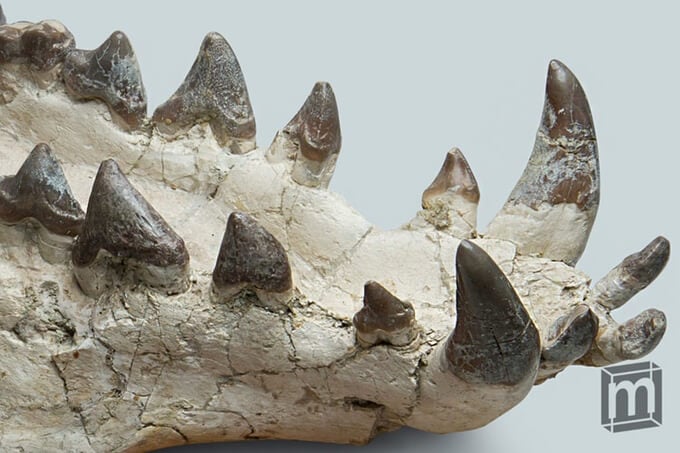
"Over the past 155 years, the enthelodonts have been audited at every taxonomic level." - Paleontologist Scott Foss, "The evolution of artiodactlis"
During the Eocene epoch a new species of predators appeared on the plains of Eurasia and North America. Entelodonts, or "hell pigs," had huge jaws that could open at an angle of almost 90 degrees. Given that some types of entelodonts reached 2 meters in the shoulders, it is easy to imagine where they came from such a name.
The sample in the mini museum was taken from the lower jaw of the Archaeotherium, an enterol- dont species the size of a cow that dominated the plains of North America for six million years.
La Brea Tar Pitts (age 38,000 years)
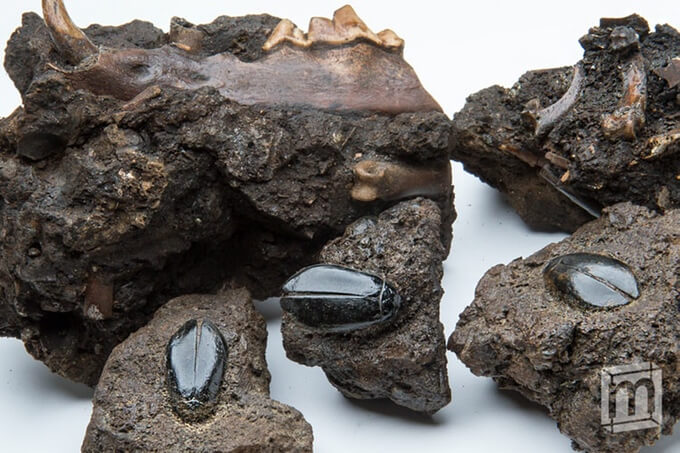
"We did not search for what lives in it." - John Harris, paleontologist and chief curator of the Page Museum
La Brea Tar Pits are the most famous oil spills in the world. Fossil remains of animals in La Brea include nearly 700 different species and are dated 40,000 years before the Late Pleistocene.
The sample in the mini museum came from the material extracted at La Brea Tar Pits, which contained the remains of coyotes, dung beetles, rabbits and even bald eagles. Recently, scientists discovered living microbial communities in these ancient layers, which led to new ways of thinking about life on Earth and elsewhere.
Meat of mammoth (age 19 551 years)
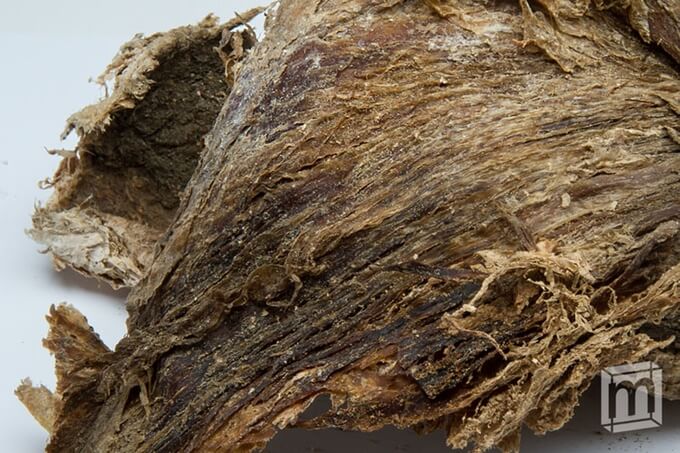
"They say scientists like steaks from the mammoth. In fact, one of them made a heroic attempt to bite off, but could not hold. ” - Bjorn Kurten, "How to freeze the mammoth"
For thousands of years, woolly mammoth has been the main food of many groups of first people throughout Europe, Asia, and then in North America. Over the past decades, the well-preserved remains of the mammoth have been found in the northern regions, once covered with ice.
A sample of the mini-museum was taken from a well-preserved woolly mammoth, discovered near the Indigirka River in Siberia, Russia; radiocarbon dating showed that his age was 19 551 years.
The Neanderthal Ax (age 40 000 - 140 000 years)
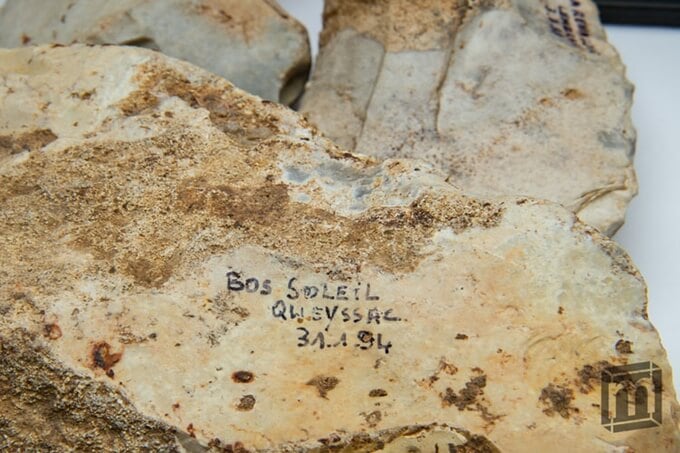
"Once we can understand why of all primates only modern people have spread to all corners of the world." - Svante Paabo, Director of Genetics, Max Planck Institute for Evolutionary Anthropology.
Once we considered them only hair-covered savages, but the stone tools discovered in the ancient cave above the French village of Le Moustier, opened our eyes to the possibilities of the culture of the Neanderthals. Additional findings have expanded this culture throughout Europe and Central Asia; they appeared not less than one hundred thousand years ago.
Recent genetic studies have also discovered the fact that many of us have the DNA of Neanderthals included in our modern genetic code. Neanderthals are not just a separate species: they are part of us.
A sample in the mini-museum hit the collection of the French postman in retirement. He spent decades exploring rural France, and collecting musterian stone tools. Experts estimate their age at 70 000-140 000 years.
Dagger of the Bronze Age (12th century BC)
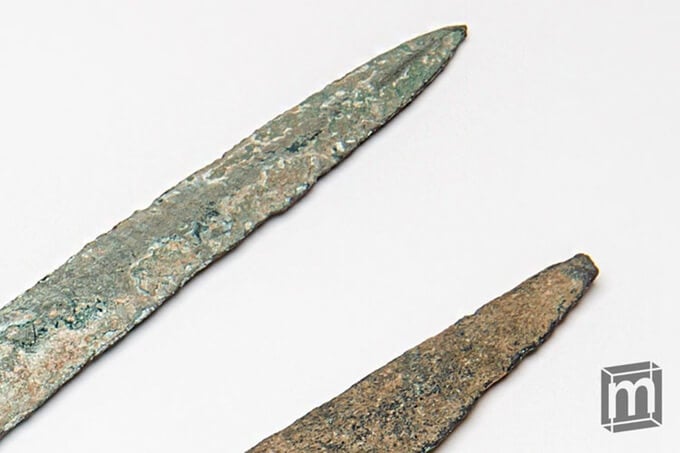
"It is not infamous for him, defending his country, to die here; but the spouse and children will live. " - Homer, The Iliad
For 2000 years, the Eastern Mediterranean was home to a number of complex Bronze Age cultures associated with complex trading routes. But at the end of the 12th century BC. e. empires from Greece and Anatolia to Egypt and Babylon collapsed in a swift wave of famine, political turmoil and war.
The sample in the mini-museum was taken from a pair of daggers dating from the end of the 12th century BC. e. style of the late Mycenaean culture. Blades were purchased in an antique house, specializing in ancient weapons.
Oasisimerica (draining ceramics)
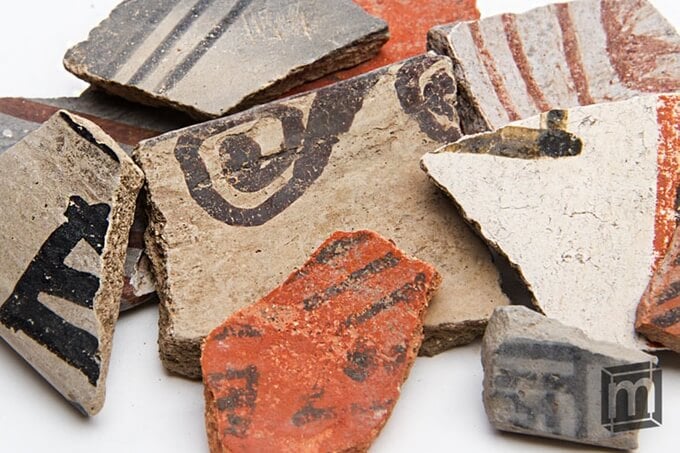
"The history of ancient indigenous peoples is represented by a chain of successive scenes and at the same time events." - Alfredo Lopez and Leonardo Lopez Lujan
The history of the American Indians is a complex network of unique societies and civilizations spanning two huge continents for many thousands of years. Our modern understanding of this story has changed dramatically over the past dozens of years, moving from ignorance to awe and awareness of the subtle links between different cultures that exist to this day.
Stretched from the southwest of the United States to North Mexico, Oasisamerica is one of the many cultural "superson". For thousands of years, several integrated agricultural societies flourished in this region. In addition to fine ceramics, they made large and complex irrigation systems, multi-storey dwellings and conducted extensive trade with other societies thousands of kilometers from them.
A sample of the mini-museum was taken from various ceramics associated with three such ancient societies: Anasazi, Mogolon and Hohokam.
Medieval Mail (15th century AD)
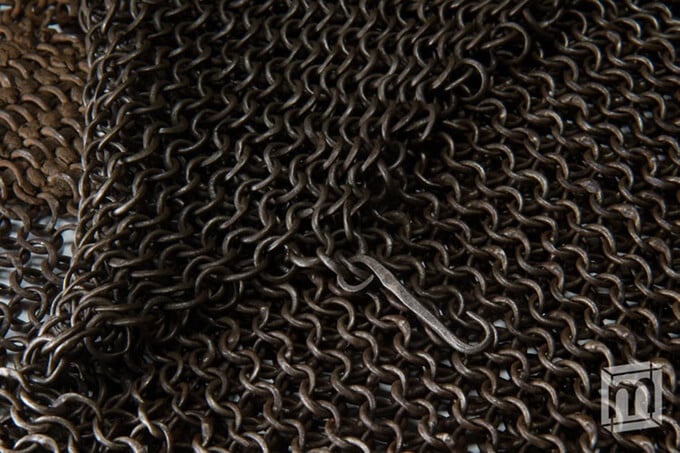
"Graham Chapman, who is also King Arthur, wore a genuine hood made of metal mail and found his weight unbearable." - Terry Jones on how to do "Monty Python and the Holy Grail"
Valuable for its flexibility in combat, chain mail was the main protective armor in Europe for more than a thousand years. Almost all the chain mail followed the pattern of four-to-one rings created by the Celts in the 5th century, when four free rings are attached to one chained ring.
The specimen in the mini-museum is a solid 15th century chainmail ring purchased at a private auction. This period is considered the heyday of chain mail, after which lamellar armor began to displace it.
Piastra from a broken ship
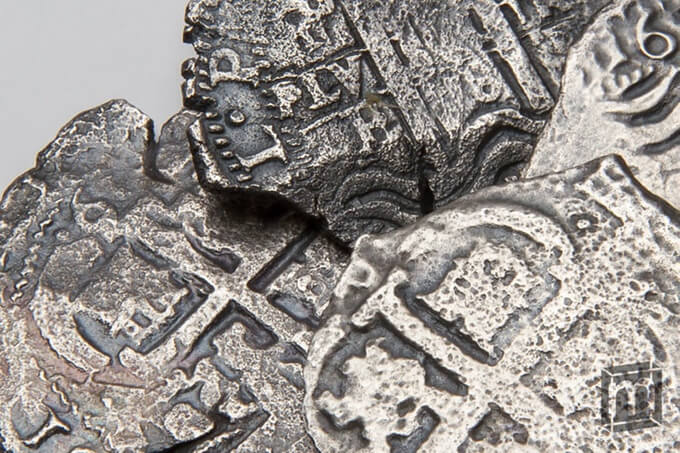
"Until now, I am dreaming at night of the breakers breaking on its banks, and I jump out of bed when I feel the hoarse voice of Captain Flint:" Piastres! " Piastres! Piastres! ". - Robert Lewis Stevenson, "Treasure Island"
Real de ocho, the Spanish "octopus", a piastre was created in 1497 and became the world's first global currency. Coins were taken in the Spanish Empire and many other countries.
The sample in the mini museum was received from the broken "Concepcion", which sank in 1641 and was rebuilt in 1978 by Bert Webber, the younger protégé of the great treasure hunter Mel Fisher.
Petrified Lightning (fulgurite)
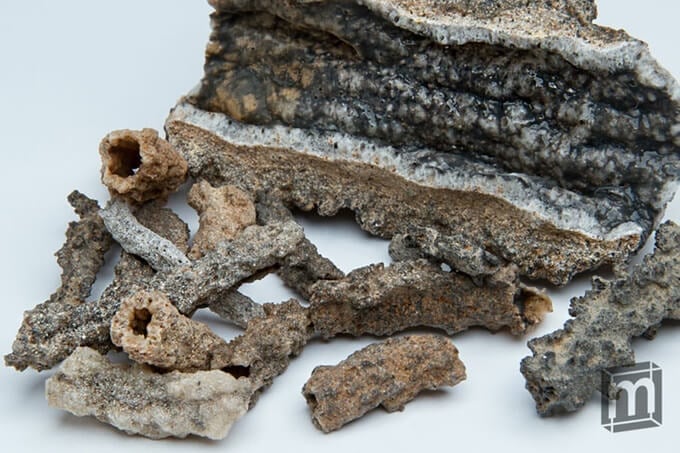
"The tube is sometimes thick with a finger, sometimes with a bird's feather ... Sometimes, if a person knows what to look for, one can see the radiance from the earth." — Пастор Дэвид Герман, Германия, 1711 год
Когда молния поражает сухой песок (миллиардом джоулей энергии), этот разряд плавит и сливает кремний в трубы грубого стекла, известного как фульгурит. Этот процесс происходит меньше ем за одну секунду, создавая сложные и красивые ветвящиеся структуры иногда больше чем на 40 дюймов в длину.
Образец мини-музея взят из фульгуритов, собранных в пустыне Сахара. Анализ фульгуритов Сахары показал, что когда-то этот регион был более гостеприимным к жизни.
«Гинденбург» (кожа дирижабля)

«О, человечество!». — Герберт Моррисон, радиорепортер, описывающий сцену вживую
Ровно в 7:25 вечера 6 мая 1937 года «Гинденбург» загорелся над небесами военно-морской станции Лейкхерст в Нью-Джерси. «Гинденбург» был самым крупным дирижаблем в истории. Его огненная гибель и смерть 36 человек положила конец полетам всего, что легче воздуха.
Образец в мини-музее представлен кусочком кожи, полученном на месте крушения журналистом Гарри Кро. Кро был местным репортером, который был командирован на ожидаемое место обычной посадки, но которое стало одним из самых хорошо запечатленных бедствий в истории.
Мост Золотые Ворота (подвесная веревка)
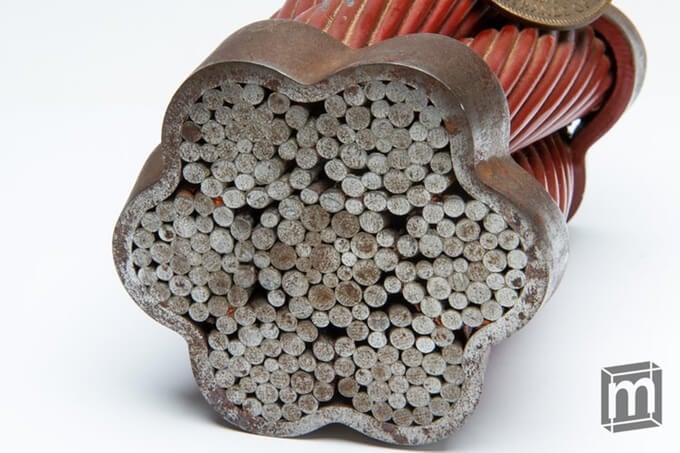
«Наконец, задача выполнена». — Джозеф Стросс, главный инженер моста Золотые Ворота
27 мая 1937 года мост Золотые Ворота был открыт для публики. Мост был чудом инженерии и смелости. Он представляет собой волю и гениальность людей, которые добились своего вопреки всему. На сегодняшний день он остается самым фотографируемым мостом в мире.
Образец в мини-музее происходит от одной из оригинальных 250 пар вертикальных подвесных канатов. Эти веревки были заменены в середине 70-х годов, и штат Калифорния продал часть этого материала, чтобы справиться с оплатой за работу. Процесс занял четыре года и сам по себе стал серьезным инженерным подвигом.
Олимпийский факел
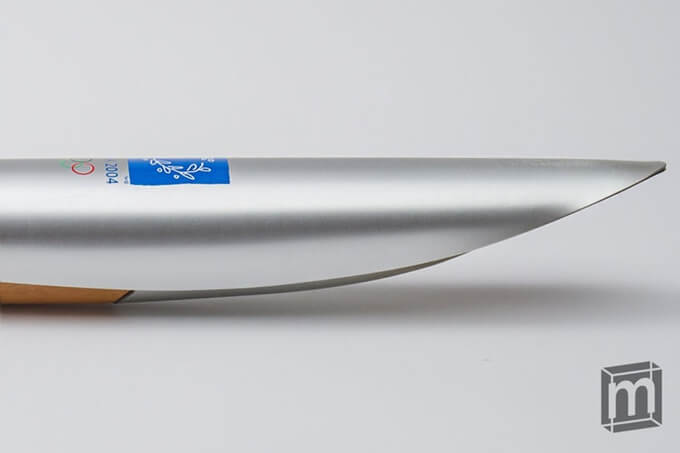
«У нас не будет мира, пока не будут пережиты предрассудки, разделяющие различные расы». — Пьер де Кубертен, основатель современных Олимпийских игр
Современные Олимпийские игры являются манифестом идеалов Пьера де Кубертена, который в 1894 году возродил идею греческой олимпиады возрастом 3000 лет как практическое дополнение движению к возрождению мира в наши дни. Целью Кубертена было не что иное, как мир во всем мире, который он надеялся наладить через программу спорта, подчеркивающего уникальную ценность каждого человеческого тела.
За последний век сам масштаб современных Олимпийских игр начал отражать сложность, присущую глобальным человеческим отношениям. Но олимпийский девиз Кубертена («Быстрее, выше, сильнее!») также служит напоминанием о неукротимости человеческого духа в самом сердце Игр.
Образец в мини-музее был сделан из факела, используемого в эстафете Олимпийского огня в Афинах в 2004 году. Эта эстафета стала первой глобальной эстафетой, когда тысячи бегунов пересекли каждый континент, кроме Антарктиды.
Кассета астронавтов («Скайлэб», 1973 год)
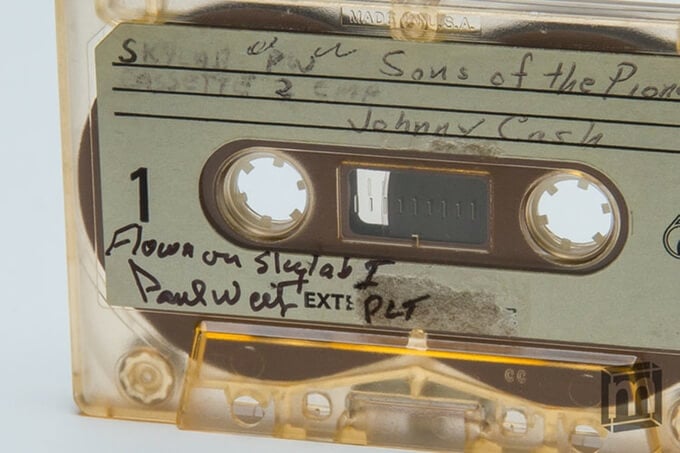
«И Хьюстон, Скайлэб Два с вами. Мы все исправим». — Пит Конрад, командир миссии
Беспилотная станция «Скайлэб» была запущена 14 мая 1973 года. В первую минуту полета микрометеороидный щит, предназначенный для защиты Skylab, развернулся слишком рано и снес две солнечных батареи космической станции. Спустя несколько дней астронавты, которые должны были активировать «Скайлэб», оказались в положении спасателей станции. Проведя рискованные выходы в космос и работая в условиях до 54 градусов по Цельсию, экипаж из трех человек, включая Пита Конрада, Джо Кервина и Пола Вейца, не только стабилизировал станцию, но и выполнил научные цели миссии.
Образец мини-музея был сделан из пленочной кассеты, подготовленной для пилота Пола Вейца. Кассета была приобретена на аукционе и оцифрована.
Первый суперкомпьютер (Cray-1)

«В скорости света что-то есть; ее так сложно обойти». — Сеймур Крэй
Cray-1 был первым коммерчески успешным суперкомпьютером. Ранние попытки создать жизнеспособный суперкомпьютер включали использование невероятно сложных интегральных схем. Сеймур Крэй воплотил идею, используя только три различных типа интегральных схем во всей машине. Этот подход позволил создать машину, которая стала легендой и позволила состояться Cray Research.
Образец мини-музея был сделан из платы памяти Cray-1, изначально установленной в Lawrence Berkeley Labs.
«Звездные войны IV» (позвонок крайт-дракона)
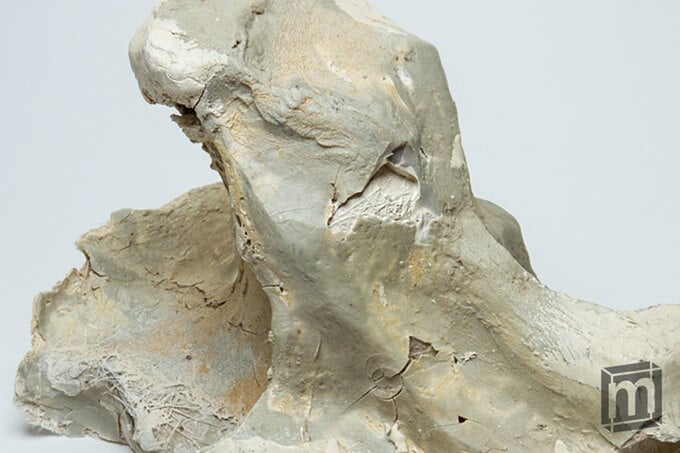
«Давным-давно, в далекой-далекой галактике…»
25 мая 1977 года Джордж Лукас выпустил на экраны кинотеатров «Зездные войны». Фильм имел мгновенный, но неожиданный успех. И очень быстро стал глобальным феноменом. На многих из нас, которые видели его в далеком детстве, он произвел неизгладимое впечатление.
Образец мини-музея был сделан из позвонка крайт-дракона, длинный скелет которого C-3PO нашел на Татуине. После съемок съемочная группа оставила крайт-дракона и несколько других наборов в тунисской пустыне. Область стала привлекательной для туристов, а также для местных жителей, которые разбирали скелет на части и продавали туристам.
Лунное дерево («Аполлон-14»)

«Мы определенно выбрали ясный день для прибытия — можно увидеть весь пути до самого горизонта». — Стюарт Руза, пилот командного модуля «Аполлона-14», при входе на лунную орбиту
В 1971 году «Аполлон-14» привез астронавтов Алана Шепарда, Эдгара Митчелла и Стюарта Рузу на Луну вместе с сотнями семян деревьев. Считалось, что семена будут нежизнеспособными, но большинство из них выжило, проросло и разошлось по лесной службе США в рамках празднования двухсотлетия страны в 1975 году и 1976 году.
Образец мини-музея был сделан из обломанной ветки первого поколения лунных деревев в кампусе Аризонского университета в Тусоне, штат Аризона. Ветка была обломана во время грозы и спасена Долорес Хилл. Ганс Фекс невероятно благодарен ей за этот редкий и необычный образец.
The article is based on materials .
- Get link
- X
- Other Apps
Comments
Post a Comment